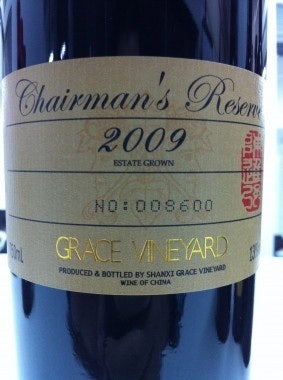"For Those Who Ask, 'Can China Make Good Wine?', The Answer Is Yes"#

Three months after the Ningxia-based winery Helan Qing Xue’s Jia Bei Lan Cabernet Dry Red 2009 won China's first-ever “International Trophy” at the Decanter World Wine Awards, this week the Chinese wine-growing region scored yet another victory, taking the top four spots in the "Ningxia vs Bordeaux Challenge" in Beijing. Jointly organized by Jim Boyce, the website TasteV, Beijing wine club Zun, and contributors to the Grape Wall of China blog, the event featured a blind tasting of ten wines — five from Ningxia and five from Bordeaux -- by five Chinese and five French judges.
Rated on quality, the top five wines as judged by the panel were:
1.
Grace Vineyard#
Chairman’s Reserve 2009 (priced at 488 yuan (US$77))
2.
Silver Heights#
The Summit 2009 (416 yuan ($65))
3.
Helan Qing Xue#
Jia Bei Lan Cabernet Dry Red 2009 (was 220 yuan ($34.50), now pending)
4.
Grace Vineyard#
Deep Blue 2009 (288 yuan ($45))
5.
Barons de Rothschild Collection#
Saga Medoc 2009 (350 yuan ($55))
Among the five French judges, the top wine at the blind tasting was Chairman’s Reserve, while the Chinese judges preferred The Summit. This fits with the observations of Silver Heights winemaker Emma Gao, who told Jing Daily this summer, "Among many of our Chinese customers, the most popular is The Summit, because it’s our most high-end wine. It’s our most expensive and probably our best. It’s great for entertaining guests."
Via the Grape Wall of China, which notes that the other wines tasted included:
Calvet#
Reserve De L’Estey Medoc 2009,
Cordier#
Prestige Rouge 2008,
Kressmann#
Grande Réserve St-Émilion AOC 2008,
Mouton Cadet#
Reserve Medoc 2009 and
Silver Heights#
Family Reserve 2009:
The wines were opened, tested for quality, bagged and tagged, in the presence of several reporters, under the supervision of Philip Osenton, who works with distributor Globus and is former head sommelier at Ritz London and restaurant manager for the Savoy. He and others, including the media, witnessed computation of the scores.
The judges had 40 minutes to rank the ten wines, which were poured before they sat. They then had a 30-minute discussion about the wines, led by professor Ma Huiqin, after which the winners were announced.
...
I know there will be many questions about this tasting. For example, French wines face ~48% in tariffs which means they have a price disadvantage versus Chinese wines. That is true. On the other hand, the prices listed above are what Chinese consumers face. [Also, two distributors told me that when taxes in Chinese wine are taken into account, it is closer to a 20% difference. I'll get more on this tomorrow.] I can provide other examples but will save that for later.
For now,
the big “takeaway” for me is that Chinese wines have again — not for the first time, not for second time, but again — shown they can compete on a global level.
(emphasis ours -- JD) The reality check: these wines represent a sliver of the China market and the industry as a whole has a long way to go. Still, for those who ask, “Can China make good wine?”, the answer is yes.
